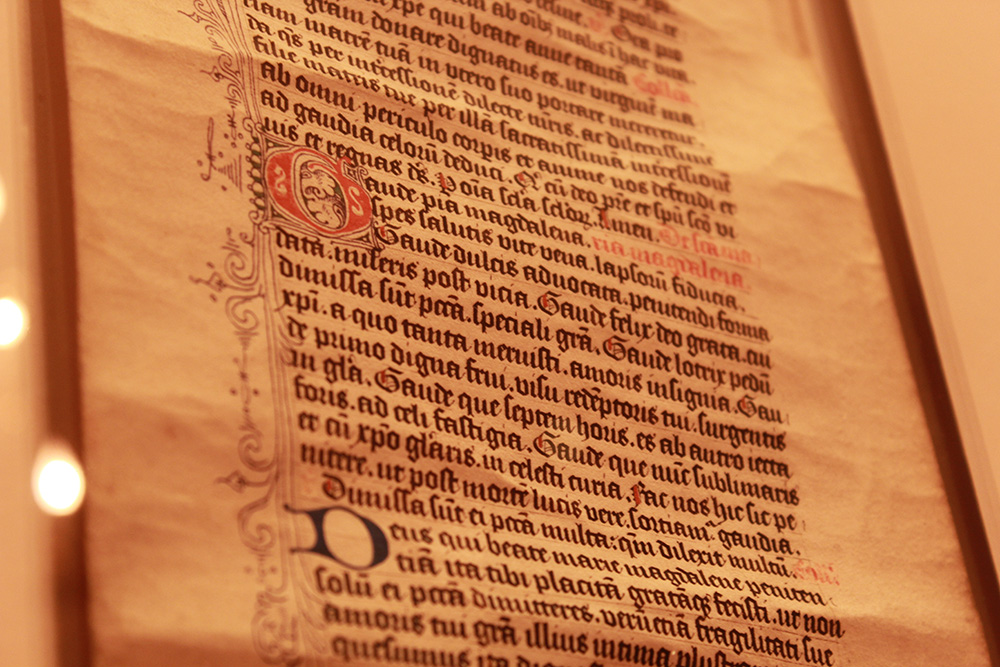What is a scroll?
A scroll, or rotulus, or roll, is a length of papyrus, leather, parchment, or paper, on which writing is preserved and which is stored in a rolled form. It is most often made by fastening several pieces together, with glue, thread, or thongs. Rolls are often, but not always, written on one side only, for reasons of convenience. An opisthographic roll is one written on both sides, either originally or in the process of re-using the blank outer side of an older scroll.
Scrolls are oriented either horizontally or vertically. The writing is sometimes arranged in columns written from top to bottom of the width, with the document held sideways for reading and writing; this is the most common layout in antiquity. (It is of course very rare for a horizontal scroll to be written in long lines across the entire long dimension, because this entails the full-length rolling of the scroll for each line of text.) Most medieval scrolls are oriented vertically, usually with a single continuous column of text (unless interrupted by diagrams or illustrations) from top to bottom; this is the arrangement in all the scrolls exhibited here
Scrolls are usually wound around a central baton, the umbilicus; the papyrus, leather, or parchment which is nearest the center, although it might bear the weight of the length of the scroll, generally receives far less wear than the outer portions, since the outer membranes must be handled at every use in reaching the center.
When were scrolls used?
The scroll is the standard way of preserving a text in antiquity; among the Egyptians, the Greeks, the Romans, and elsewhere, rolls were the standard form of book. The papyrus roll was known four thousand years B.C.E. The oldest surviving rolls are all of papyrus, a material that continued to be used until the sixth century C.E.
By the fourth century C.E., however, the codex became the most usual way of preserving a text; a codex is compact and it provides instant access to any place in the text. The spread of Christianity was accompanied by the domination of the codex, and in the Middle Ages the scroll ceased to be the main vehicle for writing. But a few scrolls continued to be made, and they are the subject of this exhibition.
Why Make Scrolls?
Scrolls continued to be made and used throughout the Middle Ages. Why was the scroll preferred to the codex? There are four reasons that suggest scroll format, and these account for essentially all medieval scrolls.
1. Scrolls whose length is not known at the beginning.
- Scrolls that record edicts, receipts, lists (see the manor court roll on display in the Houghton Library Exhibit)
- Mortuary scrolls; these traveled from place to place to announce the death of a high ecclesiastic, and to which were added prayers for the deceased at each stop, the scroll growing longer as it traveled.
- Legal decrees
2. Scrolls designed to be portable.
- Amulets, prayers, and charms (such as the Arma Christi rolls, and the Life of St. Margaret which, if worn on the body, protects during pregnancy)
- Processional scrolls, used when a full liturgical book is too much
- Actors' scrolls (rôles)
- Poetry (useful in recitation: see the Ganymede and Helena roll on display)
3. Scrolls whose text or content suggests roll format.
- Maps (itineraries for pilgrimages to Rome, the Holy Land, etc.; see the pilgrimage roll on display)
- Heraldic rolls
- Genealogies (notable examples are on display)
- Chronicles and other long formats (consider the Chronicle rolls and the Compendium of Peter of Poitiers on display).
4. Scrolls that are archaizing in nature.
- Liturgical scrolls (see the Greek liturgical scroll on display)
- Reports of church councils
These reasons also prompt the making of scrolls today; practical reasons dictate the manufacture of microfilm, cinema film, rolls of paper for printing and facsimile use, scrolling computer screens; and ceremonial considerations lead to the production of Torah scrolls, citations, and academic diplomas. Jack Kerouac kept the pages of On the Road in order by gluing each new page to the end of the previous one.
Credits
Thomas Kelly, Beverly Kienzle, Timothy Baker, William Stoneman, Lisa Fagin Davis, Leland Grigoli, Aaron Macks, Emerson Morgan, Porter White, Arlene L. Navarro, Helen Cushman, Rebecca Frankel, Honor Wilkinson, Zoey Walls, Patrick R. McCoy, Nicole Pulichene, Marina Connelly, Katherine Wrisley Shelby, Yashua Bhatti, Scott Possiel, and Sean T. McLaughlin.
